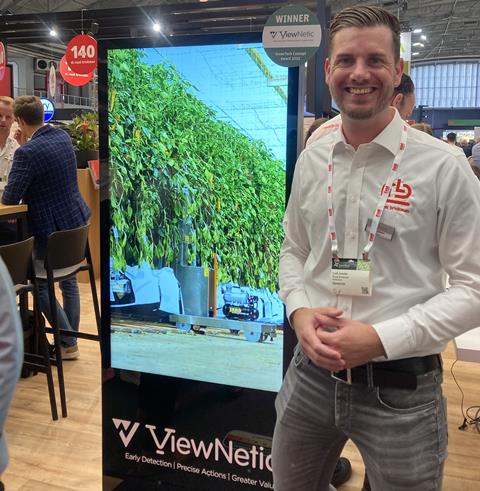ViewNetic received the Concept Award at GreenTech, with partner Royal Brinkman lauding the solution’s preventive approach to crop protection
Earlier this year, Netherlands-based horticulture specialist Royal Brinkman and Ag-tech startup ViewNetic announced a commercial partnership to boost greenhouse efficiency and reduce reliance on crop protection products. ViewNetic is a high-tech platform that uses AI and ultra-precise camera technology to detect and analyse pests and diseases at an almost microscopic level.
Royal Brinkman’s managing director Jan Schuttrups described the system as an “intelligent solution” that shifts crop protection from reactive to preventive, calling it a “vital step towards more sustainable horticulture.”

“By combining Royal Brinkman’s horticultural expertise with ViewNetic’s technological innovation, growers gain the ability to detect pests and diseases at an early stage, make better decisions and take more precise action,” the company stated.
The platform uses smart sensors to capture high-resolution images of plant parts, including the undersides of leaves, within milliseconds. “It detects pests and diseases that are invisible to the human eye — including eggs, larvae and early-stage infestations,” said Luuk Jumelet, digital manager at Royal Brinkman. “This allows growers to act sooner, with better precision and fewer inputs.”
For growers, that means fewer scouting rounds, earlier intervention and more certainty when deploying natural enemies or biological products. Instead of reacting to visible symptoms, ViewNetic provides proactive insights — supported by frequent, plant-level data.
“Instead of manual scouting, the system monitors pests and diseases per greenhouse section and provides real-time insights,” explained Schuttrups. “It can identify both pests and beneficials at every life stage, and it moves fully autonomously through the crop.”
The AI behind ViewNetic learns continuously. When it encounters an unknown species, it stores the image and updates its classification once the identity is confirmed. “With every new data point, the system becomes more accurate and reliable,” said Jumelet.
“The system translates observations into heat maps, enabling precision scouting and more targeted interventions at scale,” said Schuttrups. “Integration with the Auxin platform will connect it to a broader data ecosystem for predictive crop management.” The platform can be operated either semi- or fully autonomously.
This innovation comes at a time when growers face stricter regulation on synthetic inputs and increasing pressure from retailers to reduce chemical usage. “Few new chemical products are being authorised,” said Schuttrups. “Most new introductions are biological, which often require more precise timing and better crop monitoring to be effective. That’s making it increasingly difficult for growers to maintain crop resilience. ViewNetic gives them the tools to intervene earlier — and with greater confidence.”
ViewNetic lays the foundation for data-driven crop protection. Ongoing development is exploring how pest observations can be connected to broader greenhouse dynamics via the Auxin platform - which integrates data from various monitoring sources, with a view toward supporting targeted advice and, eventually, automated spraying.
Although still in its pilot phase, ViewNetic is currently being tested in several greenhouses in the Netherlands and is already showing promising results. “We’ve seen great outcomes,” said Jumelet. “The first commercial launch is scheduled for 2026. Interested growers can already register to join the early adopters programme.”



